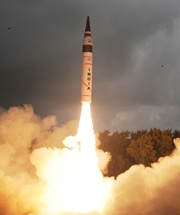India successfully tests n-capable Agni-V for second time
16 Sep 2013
India, continuing its series of missile tests as it seeks to acquire nuclear weapons capability by land, sea and air, on Sunday successfully test-fired for the second time the Agni V – the country's most potent nuclear capable inter-continental ballistic missile, which can reach Beijing and much of Europe, bringing the missile a step closer production.
 "The test was successful," said Ravi Kumar Gupta, spokesman for the Defence Research & Development Organisation (DRDO). The missile was launched from Wheeler's Island, off the coast of Odisha. "It hit the target in a predefined trajectory. It met all the mission objectives."
"The test was successful," said Ravi Kumar Gupta, spokesman for the Defence Research & Development Organisation (DRDO). The missile was launched from Wheeler's Island, off the coast of Odisha. "It hit the target in a predefined trajectory. It met all the mission objectives."
A video distributed by the DRDO showed the Agni-V rocket blasting off from a forest clearing on the island.
The Agni-V is the most advanced version of the indigenously built Agni, or Fire, series, part of a programme that started in the 1960s. Earlier versions could reach Pakistan and western China.
Nuclear-armed Pakistan is increasing its arsenal of nuclear warheads and developing short-range, tactical nuclear weapons, raising concern about an escalating South Asian arms race, the International Institute for Strategic Studies had said earlier on Thursday.
The think-tank said in a report the race with Pakistan was increasing the risk of a nuclear exchange during a conventional conflict, perhaps sparked by an act of terrorism.
The Agni-V missile was first tested in April 2012. It is mostly domestically built and has a range of about 5,000 km (3,100 miles).
Only the UN Security Council permanent members - China, France, Russia the United States and Britain - along with Israel, are believed to have such long-range weapons.
Gupta said India was now ready to start a process of production and subsequent induction of the missile.
The missile was fired from a mobile launcher at 8.48 am and started rising exactly the way it was designed to, said DRDO officials.
The 17-metre-high and two-metre-wide missile, which can carry a payload of 1.5 tonne, brings most of the countries in the world in its striking distance.
The surface-to-surface missile witnessed an 'auto launch' and detail results of the trial will be known after thorough analyses of all data retrieved from different radars and network systems, the DRDO said.
Many new technologies developed indigenously were successfully tested in the first Agni-V trial.
The redundant navigation systems, very high accuracy Ring Laser Gyro-based Inertial Navigation System (RINS) and the most modern and accurate Micro-Navigation System (MINS) had ensured the missile reach the target point within few metres' accuracy.






















